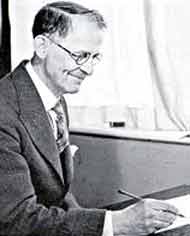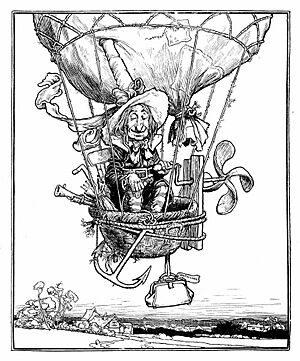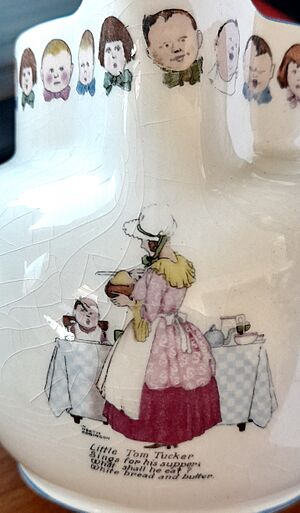W. Heath Robinson facts for kids
Quick facts for kids
W. Heath Robinson
|
|
|---|---|
 |
|
| Born | 31 May 1872 Hornsey Rise, Middlesex, England
|
| Died | 13 September 1944 (aged 72) London, England
|
| Occupation | Illustrator, cartoonist and artist |
| Known for | Drawings of odd contraptions |
William Heath Robinson (born May 31, 1872 – died September 13, 1944) was a famous English cartoonist, illustrator, and artist. He is best known for his funny drawings of very complicated machines. These machines were designed to do simple tasks in the most over-the-top ways!
The phrase "Heath Robinson" is even used in the dictionary. It describes any machine that is too complex or unbelievable. People often say "Heath Robinson contraption" for temporary fixes. These fixes use clever ideas and whatever is available, like string or tape. This phrase became very popular during World War II. At that time, Britain had shortages, and people had to "make do and mend" things.
Contents
Early Life and Artistic Family
William Heath Robinson was born in Hornsey Rise, London, on May 31, 1872. He grew up in a family of artists. His grandfather, father, and two brothers were all illustrators. His uncle was also an illustrator for a famous newspaper.
This artistic background helped William start his own creative journey.
His Amazing Career
William Heath Robinson started his career by illustrating books. He drew pictures for many classic stories. These included Danish Fairy Tales and Legends (1897) and The Arabian Nights (1899). He also illustrated Tales from Shakespeare (1902) and The Water-Babies (1915).
He was considered one of the top illustrators of his time. He even wrote and illustrated three children's books himself. These were The Adventures of Uncle Lubin (1902), Bill the Minder (1912), and Peter Quip in Search of a Friend (1922). Many people think Uncle Lubin was the start of his famous drawings of strange machines.
Cartoons and Inventions
During the First World War, Heath Robinson drew many cartoons. These cartoons showed funny and unlikely secret weapons. They were used by different countries during the war.
After the war, his art was even part of the art competition at the 1932 Summer Olympics.
He also created many humorous drawings for magazines and advertisements. In 1934, he published a collection of his favorite funny drawings called Absurdities. Some of these included:
- "The Wart Chair": A simple machine to remove a wart from your head.
- "Resuscitating stale railway scones": A way to make old train station scones fresh again.
- "The multimovement tabby silencer": A machine that automatically sprays water at noisy cats.
His cartoons were very popular. The machines he drew often used steam boilers or kettles. They were heated by candles or small lamps. Often, balding men in overalls would be tinkering with them. These machines had complex pulleys and lots of knotted string.
The term "Heath Robinson" is still used in Britain today. It describes a machine that is improbable, shaky, and needs constant fixing. In the U.S., a similar term is "Rube Goldberg".
One of his most famous series of illustrations was for the Professor Branestawm books. These stories were about a brilliant, eccentric, and forgetful professor. This was a perfect match for Robinson's funny drawings.
Around 1928, he designed a range of nursery items for a pottery company. These items, called "Fairyland on China," had scenes from sixteen nursery rhymes. They were printed on everything from eggcups to biscuit barrels.
His last project was illustrating a short story collection called Once Upon a Time. This book was published in 1944, shortly before he passed away.
During World War II, a special machine was built at Bletchley Park. This machine helped decode German messages. It was named "Heath Robinson" in his honor. It was an early version of the Colossus, one of the world's first electronic computers.
Personal Life
In 1903, William Heath Robinson married Josephine Latey. They had two children, Joan and Oliver. In 1908, they moved to Pinner, Middlesex. His house there is marked with a special blue plaque.
Later, in 1918, the family moved to Cranleigh, Surrey. Heath Robinson drew designs for local schools and groups. He was too old to fight in World War I. After the war, he even hired two German prisoners of war to help with his garden. In 1929, the family moved back to London.
Death and Legacy
William Heath Robinson died in September 1944, during the Second World War. He is buried in East Finchley Cemetery.
His legacy lives on through his art. The Heath Robinson Museum opened in October 2016. It houses nearly 1,000 of his original artworks. The museum is in Memorial Park, Pinner, near where he lived and worked.
See also
- Norman Hunter (author)
- Professor Branestawm
- Rube Goldberg, an American artist who drew similar cartoon inventions.
- Storm P., a Danish artist with similar funny inventions.
- Rowland Emett, a British cartoonist known for similar physical inventions.




